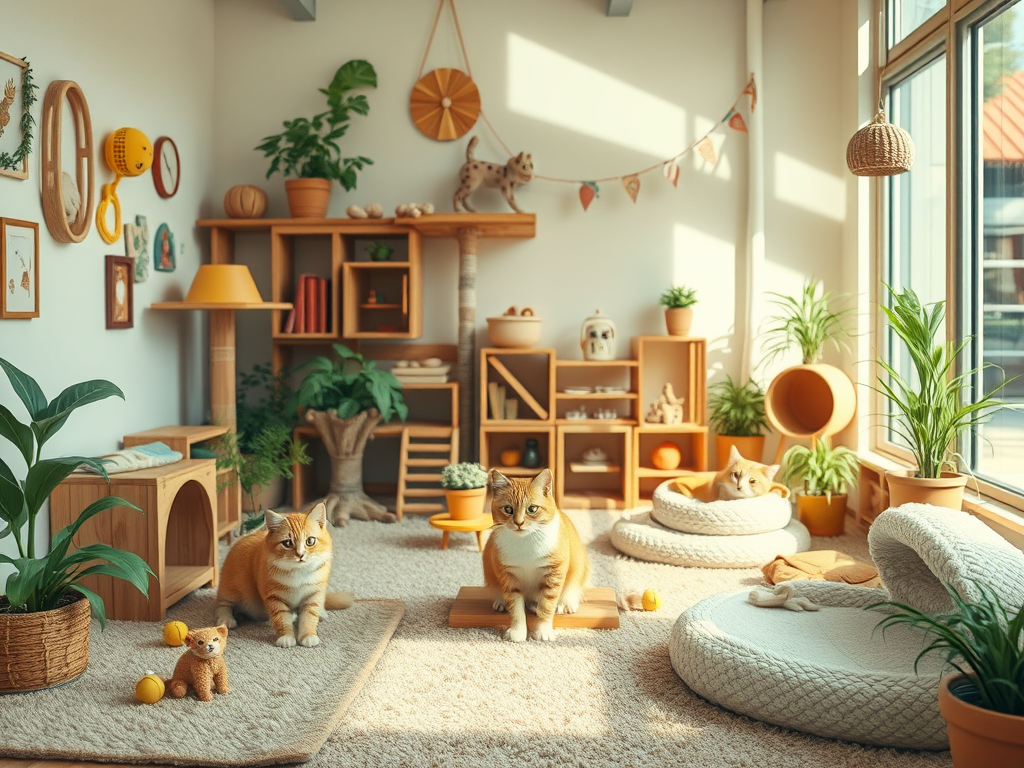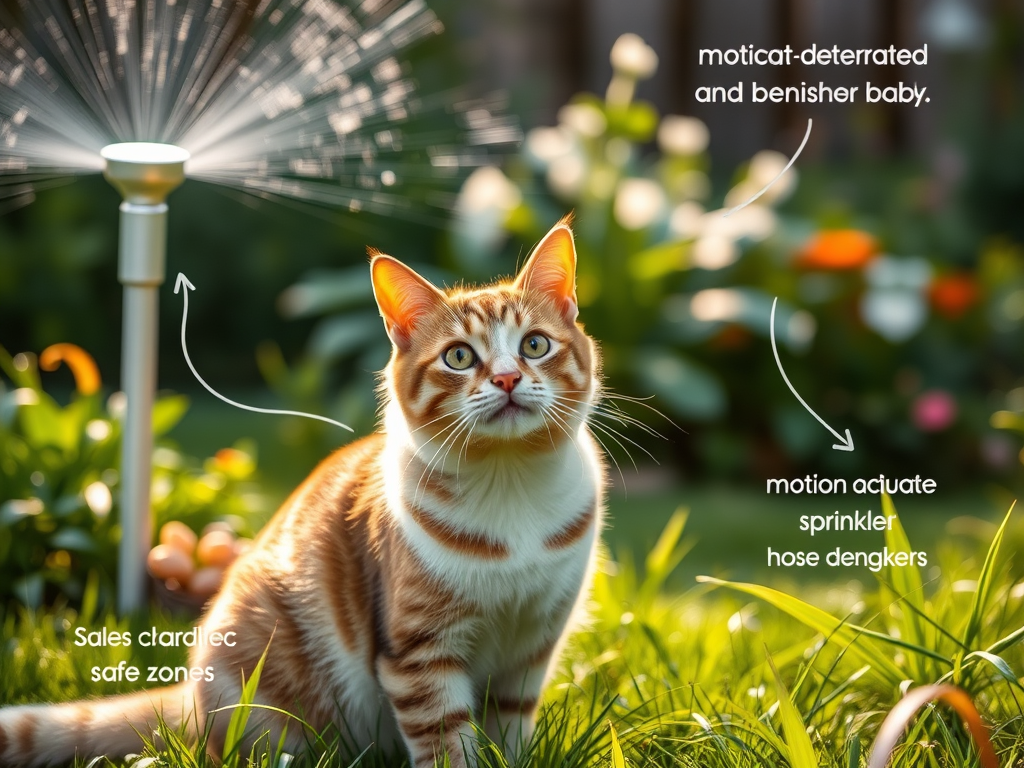Effective Strategies for Reducing Your Cat’s Hunting Behavior
Reducing the Hunting Impact of Your Cat: Cats are instinctual hunters, a trait that has been ingrained in them through generations. However, as a responsible pet owner, you can cultivate a secure indoor environment that satisfies their natural hunting instincts while safeguarding local wildlife. By creating engaging spaces and activities that stimulate their senses and instincts, you can keep your feline friend entertained and content, all while ensuring that they do not pose a threat to the unsuspecting animals outside your home.
Incorporating interactive toys into your cat’s playtime can significantly mimic their hunting experiences indoors. Toys such as feather wands, laser pointers, and remote-controlled mice can capture your pet’s interest for prolonged periods. These playthings simulate natural hunting scenarios, allowing your cat to track, chase, and pounce, effectively providing the mental stimulation and physical activity they need. By keeping them engaged with these toys, you not only entertain your cat but also enhance their overall well-being by allowing them to expend energy constructively.
Transform your living space into a feline playground by designing obstacle courses filled with creative elements like boxes, tunnels, and shelves. This unique setup encourages your cat to explore and be active, allowing them to climb, jump, and investigate different environments. Cats are inherently curious, and providing them with a diverse array of spaces to investigate mimics their natural instincts, offering them an exhilarating adventure right in their own home.
Do not overlook the value of puzzle feeders in your cat’s daily routine. These innovative devices challenge your cat mentally and replicate the effort they would typically expend while hunting. By integrating treat-dispensing puzzles into your cat’s feeding schedule, you can keep their minds sharp while providing a fun and rewarding experience. This method not only entertains your pet but promotes healthier eating habits, as they learn to earn their treats through engagement and activity.
Prioritize playtime in your household. Engaging in social interaction through play is vital for strengthening the bond between you and your cat. Make it a regular practice to schedule dedicated play sessions, using the same toys they enjoy during independent play. This shared time not only alleviates any pent-up energy or frustration your cat may experience, but it also deepens your emotional connection, making playtime a fulfilling and enjoyable experience for both of you.
Creating a stimulating indoor environment for your cat is achievable with a bit of creativity and commitment. Your home can become more than just a shelter; it can evolve into an adventurous landscape that fulfills their natural hunting instincts while keeping them safe from outside dangers. With thoughtful planning and attention to their needs, you can nurture a happy and fulfilled indoor cat.

Leash Training: A Gateway to Safe Outdoor Adventures for Your Cat
Adopting leash training can unveil a world of safe exploration for your cat. While walking is a common activity for dogs, cats can also relish outdoor adventures with the right training and a little patience. By introducing your feline companion to a harness and leash, you can allow them to enjoy nature’s beauty while ensuring their safety.
Start your leash training journey by selecting a snug-fitting harness that offers comfort to your cat. It is crucial to let your pet become accustomed to the harness before attempting to put it on them. Allow them to sniff and examine the harness, which can help alleviate any anxiety. Gradually introducing the harness at their own pace fosters positive experiences and makes the process smoother for both of you.
Once your cat is at ease with the harness, attach a lightweight leash and practice indoors. This familiar setting will help them adjust to the sensation of wearing a leash while building their confidence. Remember to be patient, as some initial resistance is normal; patience is vital in helping your cat acclimate to this new experience.
When taking your cat outside for the first time, choose a calm, secure spot like your backyard or a quiet park. Ensure that the area has minimal traffic and distractions to help your cat feel safe. Start with short outdoor sessions to avoid overwhelming your pet, gradually increasing the duration as they become more comfortable exploring their new surroundings.
Supervised outdoor time enriches their lives, allowing them to enjoy the sights, sounds, and scents of the natural world without endangering local wildlife. Picture the joy on your cat’s face as they discover new experiences in a secure environment. This bonding time not only enhances their quality of life but also strengthens your relationship.
Real-life stories from fellow cat owners can serve as motivation. Many have shared their initial skepticism regarding whether their cats would take to leash walking, but through consistency and positive reinforcement, they’ve seen remarkable progress. Celebrate each small success as a step toward broadening your cat’s horizons while ensuring their safety.
By integrating leash training into your cat’s routine, you’re creating a harmonious balance between outdoor enjoyment and wildlife protection. This approach allows your cat to explore while fostering a sense of security in their environment.
The Advantages of Catios: Crafting Safe Outdoor Spaces for Your Feline Friend
Outdoor cat enclosures, commonly known as catios, offer an excellent solution for adventurous cats yearning for outdoor experiences without the inherent risks. These secure spaces allow your feline companions to enjoy the outdoors while ensuring their safety and the protection of local wildlife.
Building or purchasing a catio can be customized to suit your available space and budget. Options range from simple balcony enclosures to more elaborate backyard constructions. The main focus should be on creating an escape-proof structure, as safety is paramount in providing a secure environment for your cat.
When designing your catio, consider incorporating multiple levels and cozy hideaways. Cats thrive in environments that feature vertical spaces and retreats. By adding platforms, ramps, and hammocks, you can transform a basic enclosure into an engaging paradise that mirrors their natural habitat.
Enhancing the sensory experience within the catio can also be advantageous. Introduce elements like cat grass, scratching posts, or natural logs to create a stimulating environment filled with diverse textures and enticing scents. This sensory enrichment keeps your cat engaged and content while allowing them to enjoy the outdoors in a controlled setting.
Routine maintenance is essential for ensuring the safety of your catio. Regularly inspect for any signs of wear and tear, including the integrity of the mesh, structure, and locks. Since cats are naturally curious and may test the limits of their enclosure, maintaining it in optimal condition is vital for their safety and well-being.
With a catio, your feline friend can revel in sunbathing, climbing, and observing wildlife without posing a threat to local ecosystems. They can bask in the sun and watch birds from the safety of their outdoor haven, enjoying their time while keeping wildlife protected.

Proven Behavioral Training Techniques to Reduce Hunting Instincts
Training your cat to minimize hunting behaviors may appear daunting, but with the right techniques, it can become a manageable undertaking. The first step involves understanding the natural instincts and behaviors that drive your cat to hunt, which is crucial for implementing effective training strategies.
Leveraging technology can significantly support your training efforts. Consider using motion-activated deterrents, such as sprinklers or noise-makers, to set boundaries that discourage hunting without disrupting other activities. Strategically zoning your yard into safe areas can redirect your cat’s attention away from potential prey and help them adjust their behavior.
Positive reinforcement is a fundamental aspect of modifying your cat’s behavior. Reward them for non-hunting actions with treats or affection. For example, if your cat responds to your call or refrains from chasing a potential target, offer them a tasty treat or extra love. This method encourages them to repeat desirable behaviors while diminishing their instinctive urge to hunt.
Incorporating clicker training can also be an effective technique. This method associates a distinct sound with positive actions, enabling your cat to connect their behavior with rewards. By clicking when they demonstrate desired behavior, you can reinforce good habits and clarify your expectations of them.
For more tailored support, consider consulting with feline behavior specialists. They can offer personalized advice and insights that address specific challenges, assisting you and your cat in coexisting harmoniously while being considerate of local wildlife.
The purpose of deterrents and training is not to punish but to guide your cat toward behaviors that prioritize their safety and that of the environment. With consistency and patience, you can redirect their instincts, leading to safer outdoor interactions for both your cat and local wildlife.
Strategic Feeding Practices to Diminish Hunting Drives in Cats
The type of food you provide and the methods you use for feeding can significantly impact your cat’s hunting instincts. Surprisingly, a well-fed cat may still exhibit hunting behaviors; however, the way you feed them can help alleviate this tendency.
Free feeding, where food remains accessible throughout the day, may not be suitable for every cat. Instead, consider implementing a structured feeding schedule. By establishing predictable mealtimes, you can help your cat become less inclined to hunt, as they learn to associate food availability with specific times of the day, thereby reducing the need to seek out prey.
Interactive feeding strategies can be transformative in modifying your cat’s behavior. Utilizing food puzzles or dispensers can mimic the act of hunting, requiring your cat to ‘work’ for their meals. This approach keeps them mentally and physically stimulated, channeling their energy in a positive direction while allowing their natural instincts to manifest in a safe manner.
Additionally, pay close attention to the nutritional quality of their food. A diet high in protein and low in carbohydrates aligns better with a cat’s natural dietary needs, potentially leading to a decrease in hunting behaviors. Collaborating with a veterinarian to customize the diet ensures that your cat’s nutritional requirements are met effectively.
Finally, offering a variety of food types can satisfy their inherent curiosity and appetite for novelty. Alternating between dry kibble, wet food, and raw diets can keep mealtime exciting, reducing the temptation to seek thrills beyond their food dish.
Feeding strategies extend beyond mere sustenance; they serve as a powerful tool for managing your cat’s behavior. By adjusting how and what you feed them, you can effectively diminish their inclination to hunt while ensuring they remain satisfied and healthy.

Cultivating Community Responsibility for Cat Conservation
Cats make delightful companions, and as their caretakers, we have a responsibility to ensure they coexist peacefully with local wildlife. By embracing community initiatives and personal accountability, we can significantly mitigate the ecological impact of free-roaming cats.
Engaging with local conservation groups is an excellent way to stay informed about wildlife-friendly practices. Many communities offer educational workshops for cat owners, addressing the ecological consequences of allowing cats to roam freely while providing solutions to mitigate these effects.
Consider initiating or joining neighborhood discussions or social media groups focused on responsible pet ownership. Sharing resources, tips, and experiences fosters a more wildlife-conscious community, creating a supportive environment for all pet owners to thrive.
One proactive approach is to establish cat-friendly zones within community gardens or parks. These designated areas can include enclosures or supervised play spaces, ensuring a safe environment for both cats and local wildlife. This collaborative effort enhances awareness and fosters positive interactions between pets and nature.
Incorporating family-friendly initiatives, such as sticker campaigns or educational contests for children and teens, can elevate awareness about responsible pet ownership and the importance of coexisting with nature.
Lead by example at home by applying the strategies you’ve learned. Whether it’s leash training, constructing catios, or modifying feeding practices, demonstrating your commitment to a harmonious relationship between your cat and the environment can inspire others to follow suit.
By blending individual actions with community-based initiatives, we can create a supportive network that balances our cats’ needs with ecological stewardship. Together, we can cherish our pets while respecting and protecting the wild spaces surrounding us.
The Article: Minimize Your Cat’s Hunting Impact Appeared First On Unity Pets.
The Article Minimize Hunting Impact of Your Cat Effectively Was Found On https://limitsofstrategy.com


Comments are closed